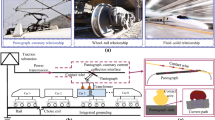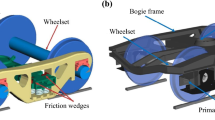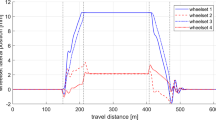Abstract
The proportional-integrative-derivative (PID) controller and the pressure control valve of a Common Rail system are modelled by taking into account electronic, electrical, hydraulic and mechanical aspects. A fully predictive model of the injection apparatus is realized and validated by means of comparison with experimental data. The effects of the PID parameters on the injection system dynamics are illustrated and discussed on the basis of model results, which refer to steadystate and transient working conditions. The influence of the accumulator size on the rail pressure time history is investigated when the rail volume is dramatically reduced (up to 2.5 cm3). In particular, the effect of the large rail pressure drop that occurs at the end of the main injection for Minirail layout solutions is examined when after injections are implemented. An objective is to try to determine possible suitable values of the PID controller parameters and of the pressure-sensor sampling-frequency for rails of reduced size.
Similar content being viewed by others
Abbreviations
- A :
-
restricted flow-area
- C :
-
geometric constant of the magnetic circuit
- CR :
-
common rail
- D :
-
diameter of the valve seat; derivative part
- ET :
-
energizing time
- F :
-
force
- G :
-
system transfer function; mass flow-rate
- I :
-
electric current; integrative part
- K :
-
gain
- M :
-
mass
- P :
-
proportional part
- PCV :
-
pressure control valve
- PID :
-
proportional-integrative-derivative control
- PWM :
-
pulse width modulation
- V :
-
volume
- S :
-
surface
- f :
-
frequency
- k :
-
spring stiffness
- m :
-
valve armature mass
- n :
-
engine speed
- p :
-
pressure
- x, ẋ, ẍ :
-
valve displacement, velocity and acceleration
- α :
-
valve-seat cone semi-angle
- β :
-
valve damping coefficient
- Δp :
-
pressure drop
- θ :
-
flux-force angle
- μ :
-
flow coefficient
- after :
-
after injection
- d :
-
derivative part
- fl :
-
flux forces
- i :
-
integrative part
- inj :
-
injected
- p :
-
proportional part
- mag :
-
magnetic
- main :
-
main injection
- nom :
-
nominal value
- pc :
-
pressure control
- tot :
-
total
References
Åström, K. J. and Hägglund, T. (1995). PID Controllers: Theory, Design and Tuning. 2nd edn. International Society of America. North Carolina, USA.
Aydogdu, O. and Korkmaz, M. (2011). A simple approach to design of variable parameter nonlinear PID controller. Int. Conf. Advancements in Information Technology, Chennai, India.
Baratta, M., Catania, A. E. and Ferrari, A. (2008). Hydraulic circuit design rules to remove the dependence of the injected fuel amount on dwell time in multijet CRsystems. J. Fluids Engineering 130, 12, 121104–1–121104–13.
Catania, A. E. and Ferrari, A. (2011). Experimnetal analysis, modelling and control of volumetric radial-piston pumps. J. Fluids Engineering 133, 8, 081103–1–081103–12.
Catania, A. E. and Ferrari, A. (2012). Development and performance assessment of the new-generation CFfuel injection system for diesel passenger cars. Applied Energy 91, 1, 483–495.
Catania, A. E., Ferrari, A., Manno, M. and Spessa, E. (2008). Experimental investigation of dynamics effects on multiple-injection common rail system performance. J. Engineering for Gas Turbines and Power 130, 3, 032806–1–032806–13.
Catania, A. E., Ferrari, A. and Spessa, E. (2009). Numericalexperimental study and solutions to reduce the dwelltime threshold for fusion-free consecutive injections in a multijet solenoid-type CRsystem. J. Engineering for Gas Turbines and Power 131, 2, 022804–1–022804–14.
Catania, A. E. and Ferrari, A. (2009). Advanced mathematical modeling of electronic unit injector systems for heavy duty diesel engine application. SAE Int. J. Commercial Vehicles 1, 1, 134–151.
Chien, K. L., Hrones, J. A. and Reswick, J. B. (1952). On the automatic control of generalized passive systems. Trans. American Society of Mechanical Engineeing, 74, 175–185.
Cohen, G. and Coon, G. (1953). Theoretical consideration of retarded control. Trans. ASME, 75, 827–834.
Ferrari, A. and Mittica, A. (2012). FEM modeling of the piezoelectric driving system in the design of directacting diesel injectors. Applied Energy, 99, 471–483.
Ferrari, A., Paolicelli, F. and Pizzo, P. (2015). Hydraulic performance comparison between the newly designed common feeding and standard common rail injection systems for diesel engines. J. Engineering for Gas Turbine and Power 138, 9, 092801–1–092801–13.
Ferrari, A. and Pizzo, P. (2017). Fully predictive common rail fuel injection apparatus model and its application to global system dynamics analyses. Int. J. Engine 18, 3, 273–290.
Ferrari, A. and Salvo, E. (2017). Determination of the transfer function between the injected flow-rate and high-pressure time histories for improved control of common rail diesel engines. Int. J. Engine Research 18, 3, 212–225.
Ferrari, A. and Vitali, R. (2017). Instantaneous torque, energy saving and flow-rate ripple analysis of a Common Rail pump equipped with different delivery-pressure control systems. Int. J. Enegine Research, DOI: https://doi.org/10.1177/1468087417740272.
Gu, J., Zhang, Y. and Gao, D. (2009). Application of nonlinear PID controller in main steam temperature control. Proc. IEEE Asia-Pacific Power and Energy Engineering Conf., Wuhan, China.
Gude, J. J. and Kahoraho, E. (2012). Kappa-tau type PItuning rules for specified robust levels. IFAC Conf. Advances in PID Control, Brescia, Italy.
Gupta, V. K., Zhang, Z. and Sun, Z. (2011). Modeling and control of a novel pressure regulations mechanism for common rail fuel injection systems. Applied Mathematical Modelling 35, 7, 3473–3483.
Hagen, J., Herrmann, O. E., Weber, J. and Queck, D. (2016). Diesel combustion potentials by further injector improvements. MTZ Worldwide 77, 4, 16–21.
Hambali, N., Masngut, A., Ishak, A. A. and Janin, Z. (2014). Process controllability for flow control system using Ziegler-Nichols (ZN), Cohen-Coon (CC) and Chien-Hrones-Reswick (CHR) tuning methods. Proc. IEEE Int. Conf. Smart Instrumentation, Measurement and Applications, Kuala Lumpur, Malaysia.
Hua, H., Ma, N., Ma, J. and Huang, H. (2013). Design of rail pressure tracking controller for novel fuel injection system. J. Shanghai Jiaotong University 18, 3, 264–270.
Leonhard, R., Parche, M., Alvarez-Avila, C., Krauß, J. and Rosenau, B. (2009). Pressure-amplified common rail system for commercial vehicles. MTZ Worldwide 70, 5, 10–15.
Matsumoto, S., Yamada, K. and Date, K. (2012). Concepts and evolution of injector for common rail system. SAE Paper No. 2012–01–1753.
Matsumoto, S., Date, K., Taguchi, T. and Herrmann, O. E. (2013). The new denso common rail diesel solenoid injector. MTZ Worldwide 74, 2, 44–48.
Meek, G., Williams, R., Thornton, D., Knapp, P. and Cosser, S. (2014). F2E–Ultra high pressure distributed pump common rail system. SAE Paper No. 2014–01–1440.
Merrit, H. E. (1967). Hydrualic Control Systems. John Wiley & Sons. Hoboken, New Jersey, USA.
Oh, B., Oh, S., Lee, L. and Sunwoo, M. (2007). Development of an injector driver for piezo actuated Common Rail injectors. SAE Paper No. 2007–01–3537.
Shinohara, Y., Takeuchi, K., Herrmann, O. E. and Laum, H. J. (2011). 3000 bar common rail system. MTZ Worldwide 72, 1, 4–8.
Xiao, W., Liang, F., Tan, W., Mao, X., Yang, L. and Zhuo, B. (2006). Analysis of common rail pressure build-up and assistant-establishment of engine phase position in starting process. SAE Paper No. 2006–01–3525.
Ziegler, J. G. and Nichols, N. B. (1942). Optimum settings for automatic controllers. Trans. ASME, 64, 759–768.
Author information
Authors and Affiliations
Corresponding author
Rights and permissions
About this article
Cite this article
Ferrari, A., Mittica, A., Pizzo, P. et al. PID Controller Modelling and Optimization in Cr Systems with Standard and Reduced Accumulators. Int.J Automot. Technol. 19, 771–781 (2018). https://doi.org/10.1007/s12239-018-0074-4
Received:
Revised:
Accepted:
Published:
Issue Date:
DOI: https://doi.org/10.1007/s12239-018-0074-4




